目录
一、概述
Gitlab 是一个开源分布式的版本控制系统。 Ruby语言开发完成。
Gitlab 主要实现的功能:
1.管理项目源代码。
2.对源代码进行版本控制。
Gitlab 的优势:
1.开源免费,搭建简单、维护成本较低、适合中小型公司。
2.权限管理,能实现代码对部分人可见,确保项目的安全性
3.离线同步,保证我们不在实时依赖网络环境进行代码提交
二、安装
0、前置条件
关闭防火墙,查看防火墙状态,如果开启就stop关闭一下
systemctl status firewalld.service1、配置yum源
vim /etc/yum.repos.d/gitlab-ce.repo
复制以下内容,然后 :wq! 保存退出
- [gitlab-ce]
- name=Gitlab CE Repository
- baseurl=https://mirrors.tuna.tsinghua.edu.cn/gitlab-ce/yum/el$releasever/
- gpgcheck=0
- enabled=1
2、更新本地yum缓存
yum makecache
3、安装gitlab社区版
- #自动安装最新版本并安装相关依赖
- yum install gitlab-ce
也可以下载想要安装的gitlab版本,使用rpm命令安装
下载地址:Index of /gitlab-ce/yum/el7/ | 清华大学开源软件镜像站 | Tsinghua Open Source Mirror
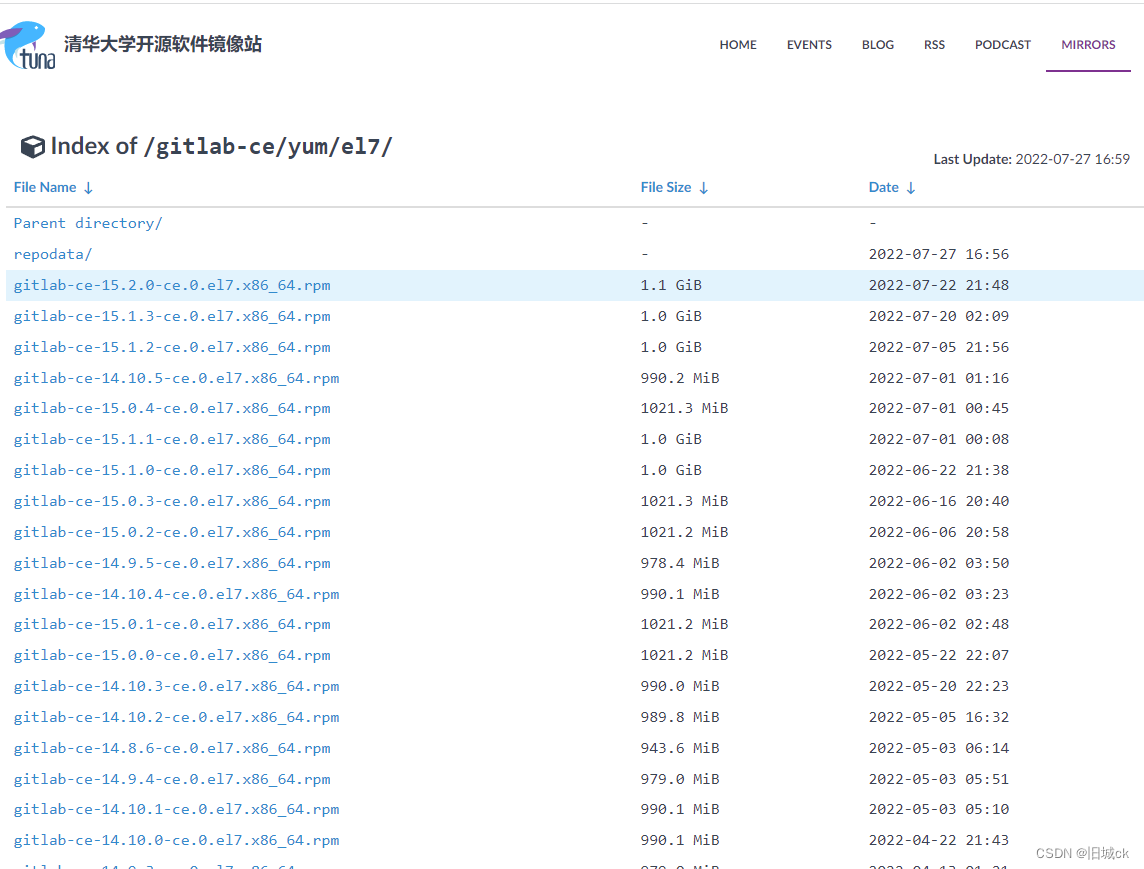
- #下载最新版本
- wget https://mirrors.tuna.tsinghua.edu.cn/gitlab-ce/yum/el7/gitlab-ce-15.2.0-ce.0.el7.x86_64.rpm --no-check-certificate
- #使用rpm安装需要手动解决依赖问题
- #前置条件依赖policycoreutils-python、openssh-server设置开机自启
- yum -y install policycoreutils-python openssh-server
- systemctl enable sshd
- systemctl start sshd
- #还缺啥安装时会有提示,缺啥安装啥就行
- rpm -Uvh gitlab-ce-15.2.0-ce.0.el7.x86_64.rpm
- #安装成功后启动
- gitlab-ctl reconfigure
- gitlab-ctl restart
4、更改配置文件参数
默认安装完成后安装目录
- gitlab组件日志路径:/var/log/gitlab
- gitlab配置路径:/etc/gitlab/ 路径下有gitlab.rb配置文件
- 应用代码和组件依赖程序:/opt/gitlab
- 各个组件存储路径: /var/opt/gitlab/
- 仓库默认存储路径 /var/opt/gitlab/git-data/repositories
- 版本文件备份路径:/var/opt/gitlab/backups/
- nginx安装路径:/var/opt/gitlab/nginx/
- redis安装路径:/var/opt/gitlab/redis
要更改配置文件我们需要修改/etc/gitlab/gitlab.rb
1)更改默认端口
- #ip为你服务器ip port你想要修改的端口号
- #修改如下:
- external_url 'http://ip:port'
- nginx['listen_https'] = false
- nginx['listen_port'] = port
- nignx['listen_address'] = ['*']
- #同时还需要修改nginx配置文件
- vim /var/opt/gitlab/nginx/conf/gitlab-http.conf
- #修改如下
- server {
- listen *:port;
- server_name ip
- if ($http_host = ""){
- set $http_host_with_default "ip:port";
- }
- }
2)配置邮箱
前置条件:需要安装postfix邮箱
- #安装
- yum install -y postfix
- #设置开机自启
- systemctl enable postfix
- #启动
- systemctl start postfi
- #修改以下内容
- gitlab_rails['gitlab_email_enabled'] = true
- gitlab_rails['gitlab_email_from'] = '发信邮箱'
- gitlab_rails['gitlab_email_display_name'] = 'xxx'
- gitlab_rails['smtp_enable'] = true
- gitlab_rails['smtp_address'] = "smtp.163.com"
- gitlab_rails['smtp_port'] = 465
- gitlab_rails['smtp_user_name'] = "发信邮箱"
- gitlab_rails['smtp_password'] = "smtp客户端授权码"
- gitlab_rails['smtp_domain'] = "163.com"
- gitlab_rails['smtp_authentication'] = "login"
- gitlab_rails['smtp_enable_starttls_auto'] = true
- gitlab_rails['smtp_tls'] = true
- gitlab_rails['smtp_openssl_verify_mode'] = 'none'
以163为例
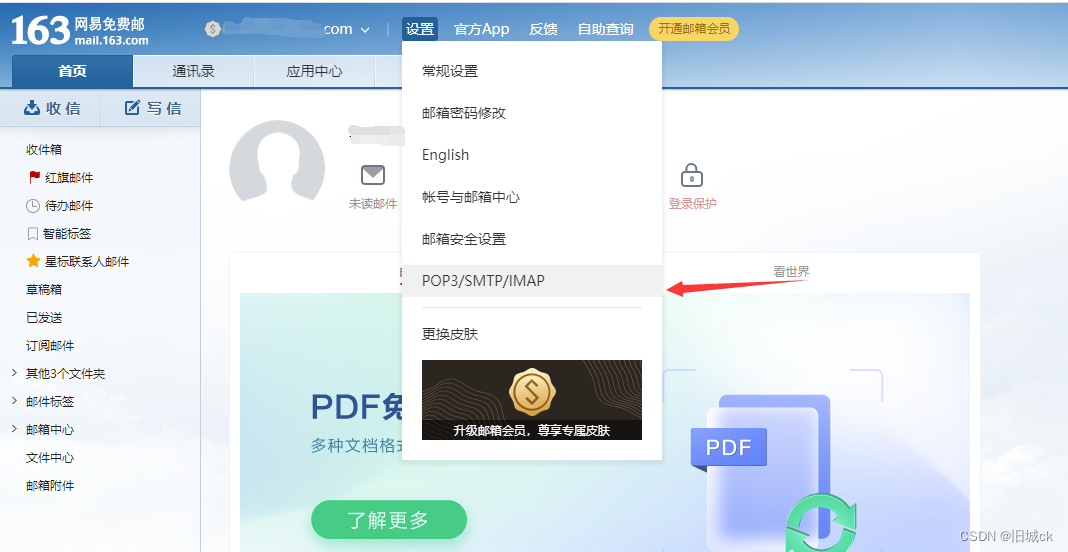
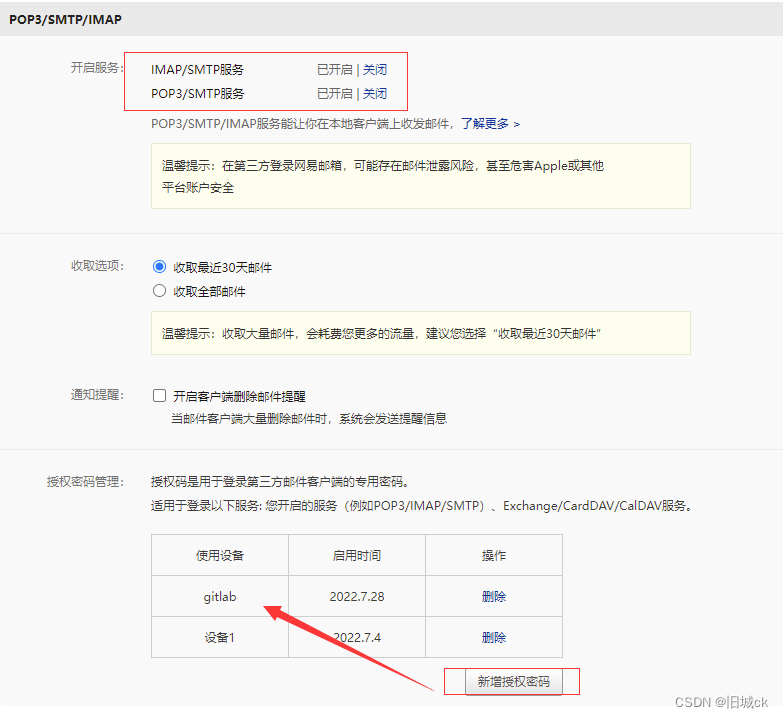
修改完成后重新加载配置文件
gitlab-ctl reconfigure
如果修改了邮箱配置,测试邮箱是否生效
- [root@localhost gitlab]# gitlab-rails console
- --------------------------------------------------------------------------------
- Ruby: ruby 2.7.5p203 (2021-11-24 revision f69aeb8314) [x86_64-linux]
- GitLab: 15.2.0 (a876afc5fd8) FOSS
- GitLab Shell: 14.9.0
- PostgreSQL: 13.6
- ------------------------------------------------------------[ booted in 14.38s ]
- Loading production environment (Rails 6.1.4.7)
- irb(main):001:0> Notify.test_email('xxx@163.com','test','gitlab').deliver_now
- Delivered mail 62e23a5839096_40bb4664558c8@localhost.localdomain.mail (1078.9ms)
- => #<Mail::Message:290380, Multipart: false, Headers: <Date: Thu, 28 Jul 2022 15:27:20 +0800>, <From: lick <lick0064@163.com>>, <Reply-To: xxx <noreply@xxx>>, <To: xxx@163.com>, <Message-ID: <62e23a5839096_40bb4664558c8@localhost.localdomain.mail>>, <Subject: test>, <Mime-Version: 1.0>, <Content-Type: text/html; charset=UTF-8>, <Content-Transfer-Encoding: 7bit>, <Auto-Submitted: auto-generated>, <X-Auto-Response-Suppress: All>>
3)修改root管理员密码
ps:初始密码可以查看
cat /etc/gitlab/initial_root_password
#登录控制台
gitlab-rails console
#查找切换账号
u=User.where(id:1).first
#修改密码
u.password='更改后的密码'
#再次确认密码
u.password='更改后的密码'
#保存
u.save!
4)性能优化
- unicorn['worker_processes'] = 2 #官方建议值为CPU核数+1(服务器只部署gitLab的情况下),可提高服务器响应速度,此参数最小值为2,设为1服务器可能卡死
- unicorn['work_timeout'] = 60 #设置超时时间
- unicorn['worker_memory_limit_min'] = "200 * 1 << 20" #减少最小内存
- unicorn['worker_memory_limit_max'] = "300 * 1 << 20" #减少最大内存
- postgresql['shared_buffers'] = "128MB" #减少数据库缓存
- postgresql['max_worker_processes'] = 6 #减少数据库并发数
- sidekiq['concurrency'] = 15 #减少sidekiq并发数
由于 Gitlab 核心功能是代码托管,所以有些额外的组件比较浪费资源,所以可以考虑关闭。
- prometheus['enable'] = false
- prometheus['monitor_kubernetes'] = false
- alertmanager['enable'] = false
- node_exporter['enable'] = false
- redis_exporter['enable'] = false
- postgres_exporter['enable'] = false
- gitlab_exporter['probe_sidekiq'] = false
- prometheus_monitoring['enable'] = false
- grafana['enable'] = false
以上就是修改配置文件!
5、重新启动
- sudo gitlab-ctl reconfigure
- sudo gitlab-ctl restart
6、其他命令
- gitlab-ctl start #启动全部服务
- gitlab-ctl restart#重启全部服务
- gitlab-ctl stop #停止全部服务
- gitlab-ctl restart nginx #重启单个服务,如重启nginx
- gitlab-ctl status #查看服务状态
- gitlab-ctl reconfigure #使配置文件生效
- gitlab-ctl show-config #验证配置文件
- gitlab-ctl uninstall #删除gitlab(保留数据)
- gitlab-ctl cleanse #删除所有数据,从新开始
- gitlab-ctl tail <service name>查看服务的日志
- gitlab-ctl tail nginx #如查看gitlab下nginx日志
- gitlab-rails console #进入控制台
- gitlab-ctl help #查看gitlab帮助信息
三、使用
安装完成后输入服务器地址和端口号就可以进行访问
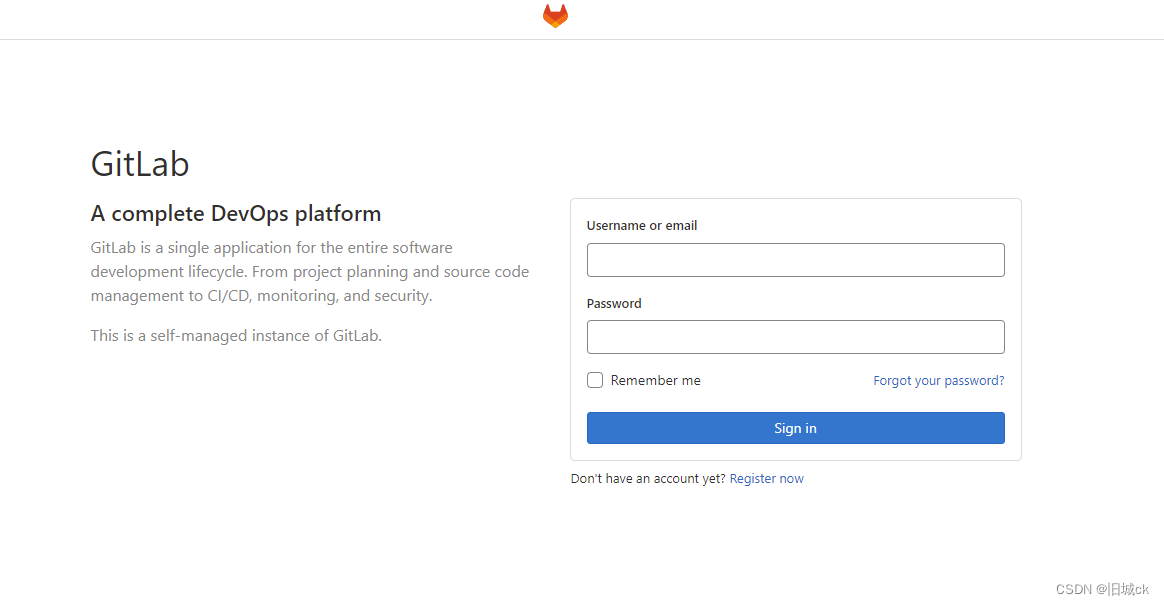
1、更改语言
root登陆后点击preferences,进入偏好设置。在这里可以设置主题颜色、语言等选项,下滑找到localization,选择中文,保存后,重新刷新页面即可

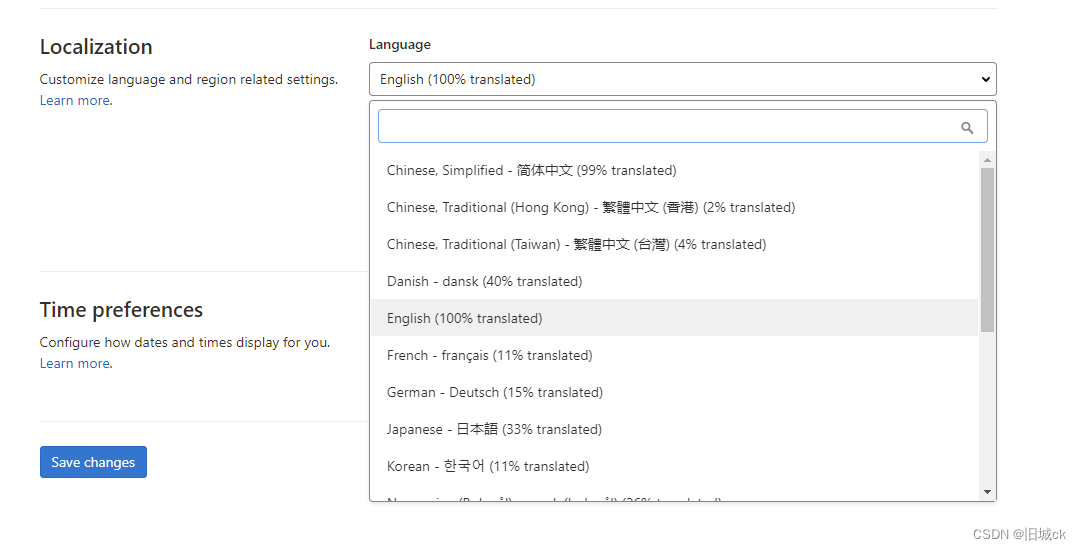
更改后界面:
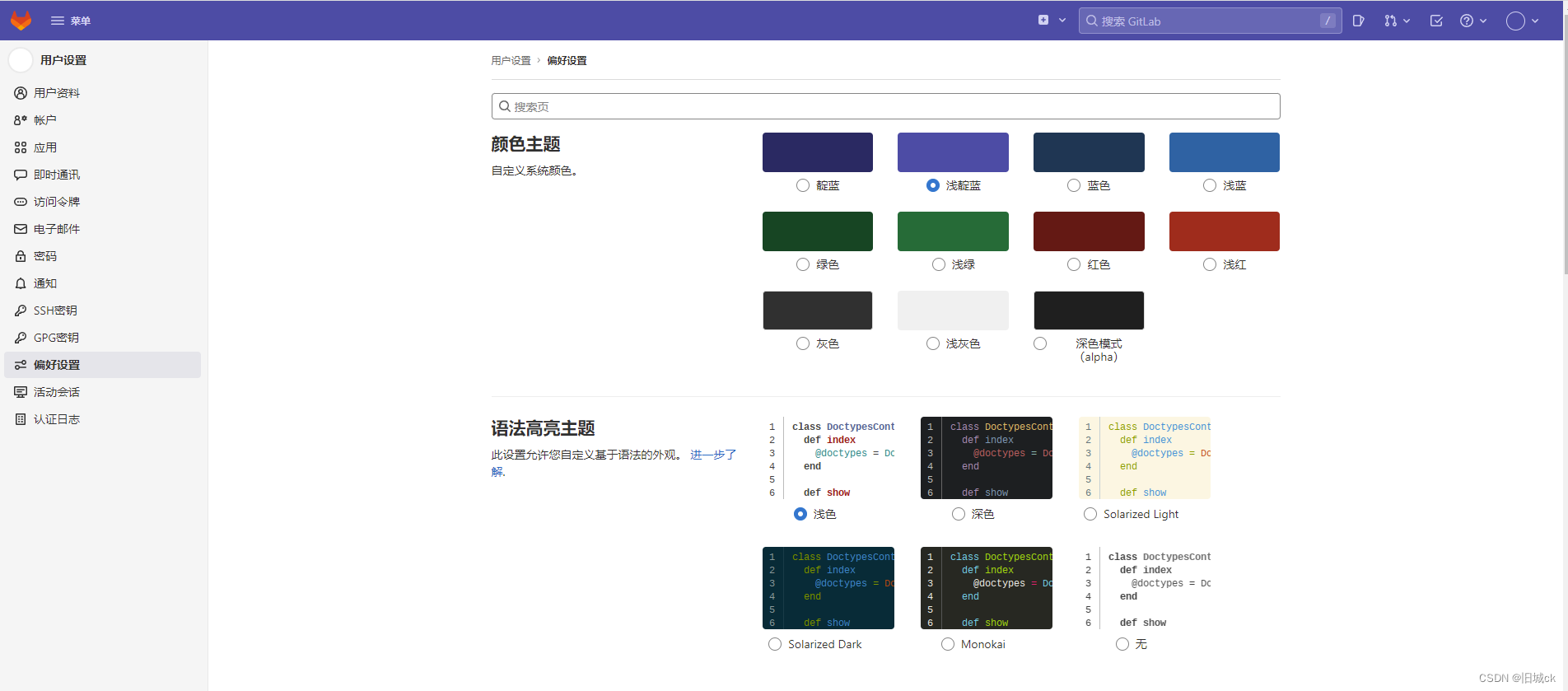
2、更改用户注册设置
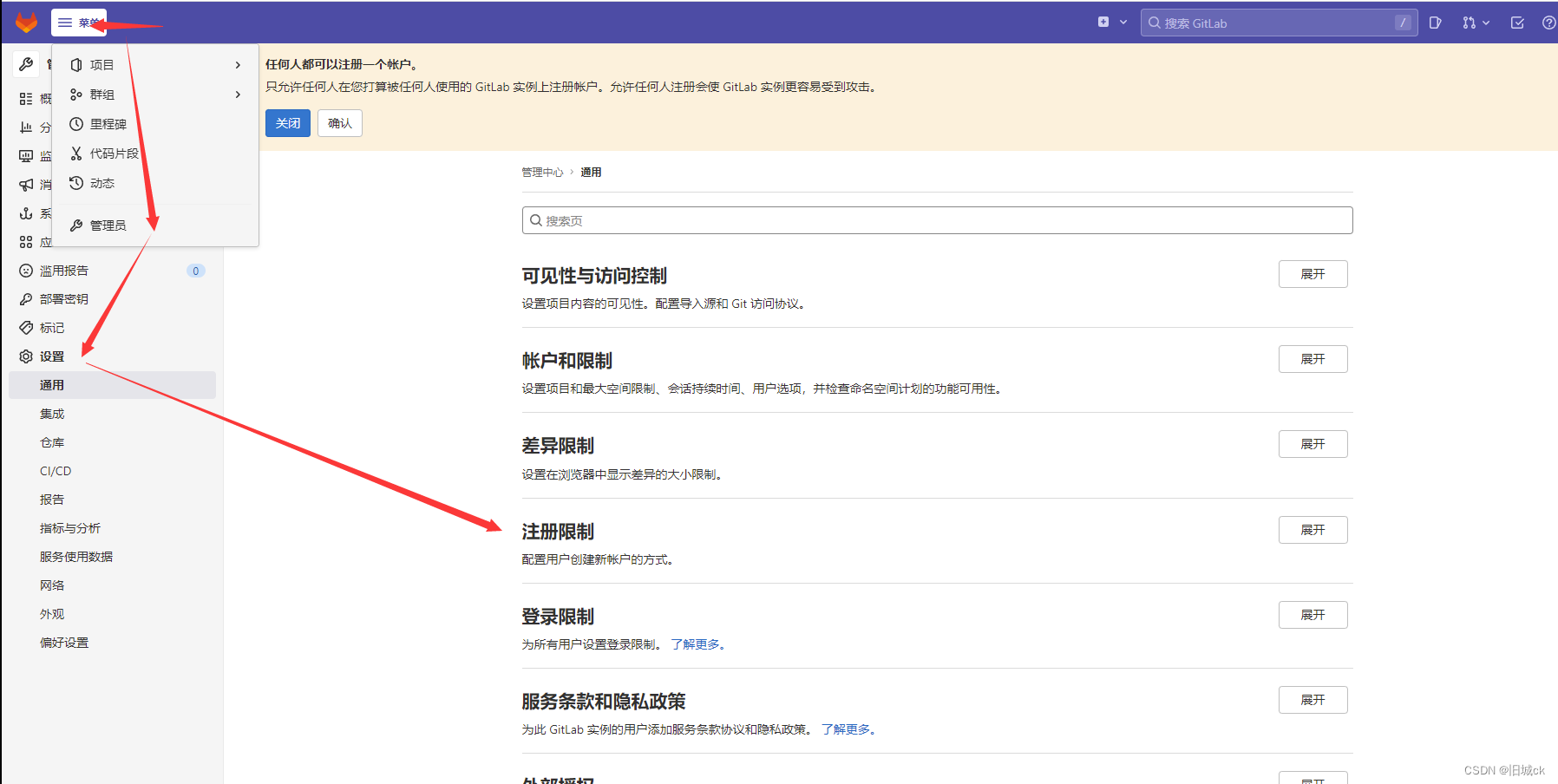
默认勾选前两个,如果是公司内网团队开发,可以设置为勾选1,3即可

以上就是本文的全部内容了,感谢您的观看,希望对您有所帮助!
出处:https://blog.csdn.net/weixin_38489509/article/details/126034654
=======================================================================================
gitlab安装rpm方式
## 安装依赖
yum -y install policycoreutils openssh-server openssh-clients postfix
yum -y install policycoreutils-python
# 设置ssh开机自启并启动
systemctl enable sshd && sudo systemctl start sshd
systemctl status sshd # 查看ssh服务
# 设置postfix开机自启并启动(有发信功能)
systemctl enable postfix && systemctl start postfix
# 下载gitlab rpm安装包并安装
wget https://mirrors.tuna.tsinghua.edu.cn/gitlab-ce/yum/el7/gitlab-ce-15.2.2-ce.0.el7.x86_64.rpm
rpm -ivh gitlab-ce-15.2.2-ce.0.el7.x86_64.rpm
# 修改gitlab配置
vim /etc/gitlab/gitlab.rb
## 加入如下
# gitlab访问地址,可以写域名。如果端口不写的话默认为80端口
external_url 'http://主机ip(172.16.137.187):端口(81)'
# 让配置生效
gitlab-ctl reconfigure
# 重新加载配置启动gitlab
gitlab-ctl reconfigure
gitlab-ctl restart
# 登录控制台修改初始密码
# 进入控制台
gitlab-rails console -e production
# 查询id为1的用户,id为1的用户是超级管理员
user = User.where(id:1).first
# 修改密码为lqz123456
user.password='#Ab123456'
# 保存
user.save!
# 退出
exit
# 登录gitla
http://gitlab地址
#账号 root 密码 #Ab123456
遇到的问题
# 报错502,其中问题解决
puma['port'] = 8181 # 使用一个未使用的端口
出处:https://blog.csdn.net/love_THL/article/details/127431077
=======================================================================================
gitlab rpm包安装方法
gitlab rpm包安装方法
当前安装方式适合centOs7版本,需要有root权限,如果当前用户不是root用户,需要配置当前用户的sudo
1. yum install -y curl policycoreutils-python openssh-server
2. systemctl enable sshd && systemctl start sshd
3. firewall-cmd --permanent --add-service=http
在执行这条命令后如果报FirewallD is not running这个错误,说明防火墙没有启动,使用systemctl start firewalld启动防火墙
4. firewall-cmd --permanent --add-service=https
5. 指定一个端口作为后续在web端访问gitlab的端口并且打开这个端口对外访问。
5.1. firewall-cmd --zone=public --list-ports 查询当前都有哪些端口可以通过外部访问
5.2. firewall-cmd --zone=public --add-port=80/tcp --permanent 打开你需要打开的端口
6. systemctl reload firewalld 重启防火墙
7. yum install postfix 安装邮件服务
8. systemctl enable postfix && systemctl start postfix
9. 使用rpm包安装命令安装gitlab的rpm包,
下载地址为https://packages.gitlab.com/gitlab/gitlab-ce社区版本
或者使用清华大学镜像https://mirrors.tuna.tsinghua.edu.cn/gitlab-ce/yum/el7/
rpm -ivh ...rpm
10. vim /etc/gitlab/gitlab.rb 修改文件中的external_url 'http://地址:端口',改为可以访问到的地址和端口
11. gitlab-ctl reconfigure:初始化gitlab配置信息并启动每一个组件,
接下来就可以在web浏览器端进行访问了。
gitlab的初始化账号为root,密码为:5iveL!fe
gitlab常用命令
1. gitlab-ctl start:启动gitlab,
2. gitlab-ctl stop:停止gitlab。
3. gitlab-ctl status:查看gitlab状态
4. gitlab-ctl restart:重启服务
出处:https://www.ngui.cc/zz/2220867.html?action=onClick
=======================================================================================
Gitlab环境快速部署(RPM包方式安装)
之前梳理了一篇Gitlab的安装CI持续集成系统环境---部署Gitlab环境完整记录,但是这是bitnami一键安装的,版本比较老。下面介绍使用rpm包安装Gitlab,下载地址:https://mirrors.tuna.tsinghua.edu.cn/gitlab-ce/yum/el7/,针对centos6和centos7的各版本Gitlab下载。如果下载不下来或者下载巨慢,可以尝试:清华大学镜像
一、GitLab简介
GitLab 是一个用于仓库管理系统的开源项目,使用Git作为代码管理工具,并在此基础上搭建起来的web服务
二、GitLab系统架构
git用户的主目录通常是/home/git(~git表示主目录路径),GitLab主要以/home/git用户身份安装在用户主目录中git。在主目录中是gitlabhq服务器软件所在的位置以及存储库(尽管存储库位置是可配置的)。裸存储库位于/home/git/repositories。GitLab是一个ruby on rails应用程序,因此可以通过研究ruby on rails应用程序的工作原理来学习内部工作的细节。为了通过SSH提供存储库,有一个名为gitlab-shell的附加应用程序,它安装在/home/git/gitlab-shell。
GitLab 应用程序是下面所述的所有组件的集合:

1. repository:代码库,可以是硬盘或 NFS 文件系统
2. Nginx:Web 入口
3. 数据库:包含以下信息:
- repository 中的数据(元数据,issue,合并请求 merge request 等)
- 可以登录 Web 的用户(权限)
4. Redis:缓存,负责分发任务
5. sidekiq:后台任务,主要负责发送电子邮件。任务需要来自 Redis
6. Unicorn:Gitlab 自身的 Web 服务器,包含了 Gitlab 主进程,负责处理快速/一般任务,与 Redis 一起工作。工作内容包括:
- 通过检查存储在 Redis 中的用户会话来检查权限
- 为 Sidekiq 制作任务
- 从仓库(warehouse)取东西或在那里移动东西
7. gitlab-shell:用于 SSH 交互,而不是 HTTP。gitlab-shell 通过 Redis 与 Sidekiq 进行通信,并直接或通过 TCP 间接访问 Unicorn
8. gitaly:后台服务,专门负责访问磁盘以高效处理 git 操作,并缓存耗时操作。所有的 git 操作都通过 Gitaly 处理
9. gitlab-workhorse:反向代理服务器,可以处理与 Rails 无关的请求(磁盘上的CSS、JS 文件等),处理Git Push/Pull 请求,处理到Rails的连接(修改由Rails发送的响应或发送给 Rails 的请求,管理 Rails 的长期 WebSocket 连接等)。
10. mail_room:处理邮件请求。回复 GitLab 发出的邮件时,GitLab 会调用此服务
Sidekiq. Unicorn 和 GitLab-shell 是GitLab中处理任务的 3 个程序。
三、Gitlab安装、配置、启动管理
安装Gitlab必要的依赖项,还将在系统防火墙中打开HTTP和SSH访问
安装命令:yum install -y curl policycoreutils-python openssh-server
激活命令:systemctl enable sshd
启用命令:systemctl start sshd
防火墙命令:firewall-cmd --permanent--add-service=http && systemctl reload firewalld
安装Postfix以发送通知电子邮件
安装命令:yum install postfix
激活命令:systemctl enable postfix
启用命令:systemctl start postfix
下载GitLab软件包(社区版),地址:https://packages.gitlab.com/gitlab/gitlab-ce
查看Gitlab相关目录,命令:find / -name gitlab
Gitlab目录结构
/opt/gitlab/ # 主目录
/etc/gitlab/ # 放置配置文件
/var/opt/gitlab/ # 各个组件
/var/log/gitlab/ # 放置日志文件
/var/opt/gitlab/git-data/repositories #数据库的地址
/var/opt/gitlab/postgresql/data #gitlab组和项目的地址
/etc/gitlab/gitlab.rb #gitlab配置文件
初始化Gitlab命令(保存配置或重新载入配置):gitlab-ctl reconfigure
Gitlab服务的启停管理
启动服务: gitlab-ctl start
停止服务: gitlab-ctl stop
重启服务: gitlab-ctl restart
查看状态: gitlab-ctl status
Gitlab的supervisor方式启动服务
服务启动命令: systemctl start gitlab-runsvdir.service
服务停止命令: systemctl stop gitlab-runsvdir.service
服务重启命令: systemctl restart gitlab-runsvdir.service
服务开机启动命令: systemctl enable gitlab-runsvdir.service
取消开机启动命令: systemctl disable gitlab-runsvdir.service
服务查看命令: systemctl list-unit-files
Gitlab服务日志查看:/usr/bin/gitlab-ctl tail #可以查看到gitlab所有插件的日志情况
四、Centos下Gitlab快速安装的操作记录
1. Gitlab安装过程(最好找一台环境比较干净的机器):
| 1 2 3 4 5 6 7 8 9 10 11 12 13 14 15 16 17 18 19 20 21 22 23 24 25 |
1)配置系统防火墙,把HTTP和SSH端口开放(关闭iptables或者开放ssh).
[root@gitlab ~]# /etc/init.d/iptables stop
[root@gitlab ~]# yum install curl openssh-server postfix cronie policycoreutils-python
[root@gitlab ~]# service postfix start
[root@gitlab ~]# chkconfig postfix on
[root@gitlab ~]# lokkit -s http -s ssh //如果iptables关闭了,这条命令就无需执行了。这条命令是用来设置防火墙的,开放http和ssh访问端口
2)下载gitlab的rpm安装包
已提前下载放到百度云里:
http://pan.baidu.com/s/1c2EPRLQ
提前密码:qys2
[root@gitlab ~]# rpm -ivh gitlab-ce-9.4.5-ce.0.el6.x86_64.rpm --force
安装后的gitlab默认路径是/opt/gitlab(程序路径)、 /var/opt/gitlab(配置文件路径)。
3) 接着进行配置
[root@gitlab ~]# gitlab-ctl reconfigure
上面配置命令执行后,如没有报错,就说明gitlab配置成功。配置后会生成各应用服务配置文件,放在/opt/gitlab/etc下,日志路径为/var/log/gitlab/
4)然后启动gitlab
[root@gitlab ~]# gitlab-ctl start
[root@gitlab ~]# gitlab-ctl status
5)最后就可以使用http://localhost顺利访问Gitlab了。整个安装过程大概10分钟搞定(rpm包下载比较费时间)
|
将ip访问修改为域名访问的更改方法:
?| 1 2 3 4 5 6 7 8 9 10 11 12 13 14 15 16 17 18 19 20 |
1)首先将/etc/gitlab/gitlab.rb文件中的192.168.1.24全部替换为gitlab.kevin.com
[root@code-server gitlab]# vim /etc/gitlab/gitlab.rb
external_url 'http://192.168.1.24'
改为:
external_url 'http://gitlab.kevin.com'
2)其次将下面两文件中的192.168.1.24全部替换为gitlab.kevin.com
/var/opt/gitlab/gitlab-shell/config.yml
/var/opt/gitlab/gitlab-rails/etc/gitlab.yml
下面两文件都是上面两文件的软链接,修改上面两个文件即可
[root@code-server gitlab]# ll /opt/gitlab/embedded/service/gitlab-rails/config/gitlab.yml
lrwxrwxrwx 1 root root 43 Nov 9 18:00 /opt/gitlab/embedded/service/gitlab-rails/config/gitlab.yml -> /var/opt/gitlab/gitlab-rails/etc/gitlab.yml
[root@code-server gitlab]# ll /opt/gitlab/embedded/service/gitlab-shell/config.yml
lrwxrwxrwx. 1 root root 39 Jun 11 20:04 /opt/gitlab/embedded/service/gitlab-shell/config.yml -> /var/opt/gitlab/gitlab-shell/config.yml
3)然后将下面文件中的192.168.1.24全部替换为gitlab.kevin.com
/var/opt/gitlab/nginx/conf/gitlab-http.conf
4)最后执行"gitlab-ctl reconfigure"命令使之配置生效(注意最好不要执行"gitlab-ctl restart",只执行本命令即可)
|
2. Gitlba安装后的几个细节的配置
?| 1 |
Gitlab如果是编译安装的默认管理员账号密码是:admin@local.host|5iveL!fe,如果是 rpm包安装则管理员账号密码是root|5iveL!fe
|
Gitlab安装后,http://localhost访问,首次访问的时候,如果不知道管理员账号和密码,尽管可以注册用户,但注册的用户都不是管理员。这个时候,可以重置管理员的密码,管理员默认是root。
重置管理员密码(密码要是8位)的方法如下:
| 1 2 3 4 5 6 7 8 9 10 11 12 13 14 15 16 17 18 19 20 21 22 |
[root@gitlab ~]# gitlab-rails console production
Loading production environment (Rails 4.1.1)
irb(main):001:0> user = User.where(id:1).first
irb(main):002:0> user.password='12345678'
irb(main):003:0> user.save!
这样,Gitlab管理员的登录权限就是:root/12345678,管理员的默认邮箱是部署机的本机邮箱,也是从本机发的邮件。这也就是为什么在开头要安装postfix。
修改下面几处,否则邮件发出后,点击会报错。下面的192.168.1.24是部署机ip。
[root@gitlab ~]# cd /opt/gitlab/
[root@gitlab gitlab]# cat embedded/service/gitlab-rails/config/gitlab.yml|grep 192.168.1.24
host: 192.168.1.24
email_from: gitlab@192.168.1.24
[root@gitlab gitlab]# cd /var/opt/gitlab/
[root@gitlab gitlab]# cat ./gitlab-rails/etc/gitlab.yml|grep 192.168.1.24
host: 192.168.1.24
email_from: gitlab@192.168.1.24
最后重启gitlab-ctl生效
[root@gitlab gitlab]# gitlab-ctl restart
|
在管理员账号(root)登录后,先把"注册"功能关了,这样就只能在管理员账号下创建用户。关闭注册功能方法:
访问http://192.168.1.24/admin/application_settings,如下:
关闭"Sign-up enabled"功能(特别注意:Sign-in enabled登录功能不要关闭了,看清楚!)

3. Gitlab批量添加账号
?| 1 2 3 4 5 6 7 8 9 10 11 12 13 14 15 16 17 18 19 20 21 22 23 24 25 |
[root@gitlab ~]# cat gitlab.sh
#!/bin/bash
#批量创建gitlab用户
userinfo="userinfo.text"
while read line
do
password=`echo $line | awk '{print $1}'`
mail=`echo $line | awk '{print $2}'`
username=`echo $line | awk '{print $3}'`
name=`echo $line | awk '{print $4}'`
curl -d "reset_password=$password&email=$mail&username=$username&name=$name&private_token=ucUctguWU6-2qrvRnGiB" "http://192.168.1.24/api/v4/users"
done <$userinfo
[root@gitlab ~]# cat userinfo.text
1 zhanjiang.feng@wang.com zhanjiang.feng zhanjiang.feng
1 hongkang.yan@wang.com hongkang.yan hongkang.yan
1 yansong.wang@wang.com yansong.wang yansong.wang
1 bo.xue@wang.com bo.xue bo.xue
1 junlong.li@wang.com junlong.li junlong.li
1 luyu.cao@wang.com luyu.cao luyu.cao
1 xueqing.wang@wang.com xueqing.wang xueqing.wang
1 xu.guo@wang.com xu.guo xu.guo
1 bing.xing@wang.com bing.xing bing.xing
1 mengmeng.li@wang.com linan linan
|
注意:上面userinfo.text文件里的四行分别表示密码,邮箱,用户名,别名。上面命令执行后,就可以批量创建用户了!
其中密码用1表示重置密码,也就是用户创建之后,会给用户邮箱发送两封邮件:
-> 一封确认绑定邮箱的邮件,一定要点击这个邮件里的confirm确认地址(否则登录无效);
-> 另一封是重置用户密码的邮件。重置后就可以使用邮箱或用户名登陆了。
注意上面脚本中的private_token(这个很重要,否则批量创建不了用户)的值是从gitlab的管理员账号登录后的"settings-Account"界面里找到的,如下:

访问脚本中gitlab的用户接口地址http://192.168.1.24/api/v4/users,试试能否访问!
Email的smtp设置
?| 1 2 3 4 5 6 7 8 9 10 11 12 13 14 15 16 17 18 19 20 21 22 23 24 25 26 27 28 29 30 31 32 |
上面默认是用部署机本地的postfix发邮件。如果要想使用第三方邮箱发邮件,这就需要修改/var/opt/gitlab/gitlab-rails/etc/unicorn.rb文件:
[root@gitlab ~]# # cat /etc/gitlab/gitlab.rb|grep -v "^#"|grep -v "^$"
external_url 'http://192.168.1.24'
gitlab_rails['gitlab_email_from'] = 'wangshibohaha@163.com'
gitlab_rails['smtp_enable'] = true
gitlab_rails['smtp_address'] = "smtp.163.com"
gitlab_rails['smtp_port'] = 25
gitlab_rails['smtp_user_name'] = "wangshibohaha@163.com"
gitlab_rails['smtp_password'] = "*******"
gitlab_rails['smtp_domain'] = "163.com"
gitlab_rails['smtp_authentication'] = "login"
gitlab_rails['smtp_enable_starttls_auto'] = true
user['git_user_email'] = "wangshibohaha@163.com"
由于该文件会影响gitlab-ctl指令,如果改动了则需要重新运行配置。
注意这个重新配置的动作要在上面细节配置之前,否则上面的配置在reconfigure之后就会被覆盖到默认状态!
[root@gitlab ~]# gitlab-ctl reconfigure
--------------------------------------------------------------------------------------------
上面使用的是163邮箱,下面再贴下公司企业邮箱(用的是Coremail论客邮件系统,注意邮箱的smtp地址要正确)的配置:
[root@gitlab ~]# cat /etc/gitlab/gitlab.rb|grep -v "^#"|grep -v "^$"
external_url 'http://192.168.1.24'
gitlab_rails['gitlab_email_from'] = 'notice@vdholdhaha.com'
gitlab_rails['smtp_enable'] = true
gitlab_rails['smtp_address'] = "smtp.icoremail.net"
gitlab_rails['smtp_port'] = 25
gitlab_rails['smtp_user_name'] = "notice@vdholdhaha.com"
gitlab_rails['smtp_password'] = "notice@123"
gitlab_rails['smtp_domain'] = "icoremail.net"
gitlab_rails['smtp_authentication'] = "login"
gitlab_rails['smtp_enable_starttls_auto'] = true
user['git_user_email'] = "notice@vdholdhaha.com"
|
修改Gitlab登录界面

选择gitlab新的主题风格,新主题会在左边栏展示选择项




经过上面修改后,看下新的登录界面

Gitlab整合Ldap(或AD域)
?| 1 2 3 4 5 6 7 8 9 10 11 12 13 14 15 16 17 18 19 20 21 22 23 24 25 26 27 28 29 30 31 32 33 34 35 36 37 38 39 40 41 42 43 44 45 46 47 48 49 50 51 52 53 54 55 56 57 58 59 60 61 62 |
如上已经顺利部署了Gitlab环境,又在一台空闲的Windows server 2008上安装了AD域。
现在需要在Gitlab上整合AD域,实现Gitlab只能使用AD域里面的账号登录。配置记录如下:
AD域的信息:
主机地址:192.168.10.141
端口:389
配置如下:
[root@gitlab ~]# vim /etc/gitlab/gitlab.rb
......
gitlab_rails['ldap_enabled'] = true
gitlab_rails['ldap_servers'] = YAML.load <<-EOS # remember to close this block with 'EOS' below
main: # 'main' is the GitLab 'provider ID' of this LDAP server
label: '哈哈集团-Gitlab登录入口'
host: '192.168.10.141'
port: 389
uid: 'userPrincipalName'
method: 'plain' # "tls" or "ssl" or "plain"
allow_username_or_email_login: false
bind_dn: 'cn=王一,ou=技术运维部,dc=kevin,dc=com'
password: '9oGlYkgDzhp5k6JZ'
active_directory: true
base: 'ou=技术运维部,dc=kevin,dc=com'
user_filter: ''
EOS
接着执行下面命令,使上面配置生效:
[root@gitlab ~]# gitlab-ctl reconfigure //这里最好使用该命令,表示重载配置。不要使用"gitlab-ctl restart"重启服务,否则可能出现500报错!
然后执行下面命令,检查LDAP信息是否成功同步过来
[root@gitlab ~]# gitlab-rake gitlab:ldap:check
Checking LDAP ...
Server: ldapmain
LDAP authentication... Success
LDAP users with access to your GitLab server (only showing the first 100 results)
DN: CN=李某某,OU=技术运维部,DC=kevin,DC=com userPrincipalName: limoumou@kevin.com
DN: CN=李二,OU=技术运维部,DC=kevin,DC=com userPrincipalName: lier@kevin.com
DN: CN=lier1,OU=技术运维部,DC=kevin,DC=com userPrincipalName: lier1@kevin.com
DN: CN=test,OU=技术运维部,DC=kevin,DC=com userPrincipalName: test@kevin.com
DN: CN=王一,OU=技术运维部,DC=kevin,DC=com userPrincipalName: wangyi@kevin.com
DN: CN=张三,OU=技术运维部,DC=kevin,DC=com userPrincipalName: zhangsan@kevin.com
DN: CN=张三,OU=网络,OU=技术运维部,DC=kevin,DC=com userPrincipalName: zhangsan02@kevin.com
DN: CN=赵四,OU=网络,OU=技术运维部,DC=kevin,DC=com userPrincipalName: zhaosi@kevin.com
Checking LDAP ... Finished
=========================================================================================
注意:
如上配置中,随便使用AD域中的一个有读权限的账号和其密码进行配置就行了,即将其他账号读出来!
AD域或Openldap搭建的时候,域名最好用邮箱域名。
uid表示属性
uid: 'uid' //默认配置是这个,如果不改,上面check ldap就不会成功,即不能成功同步ldap账号信息。
uid: 'cn' //这个表示可以使用cn名称登录,比如王一,如果cn名称是英文名(比如test),则还可以使用带域名形式登录(比如test@kevin.com)
uid: 'Samaccountname' //这个表示可以使用wangyi或wangyi@kevin.com登录
如果uid配置成上面的cn和Samaccountname,那么下面的
allow_username_or_email_login: true
label: '哈哈集团-Gitlab登录入口' 该配置表示使用LDAP账号登录时显示的界面提示信息。
|


取消Gitlab默认的登录窗口,访问http://192.168.1.24/admin/application_settings (注意不要勾选下面的"Sign-in enabled"选择)

Gitlab访问出现403"Forbidden"现象
出现的可能原因:较多的并发导致的访问被拒绝, Gitlab使用rack_attack做了并发访问的限制!
解决办法:
打开/etc/gitlab/gitlab.rb文件,查找 gitlab_rails['rack_attack_git_basic_auth'] 关键词,取消注释,
修改ip_whitelist白名单属性,加入Gitlab部署的IP地址。
修改如下(192.168.1.24):
?| 1 2 3 4 5 6 7 8 9 |
[root@gitlab ~]# vim /etc/gitlab/gitlab.rb
......
gitlab_rails['rack_attack_git_basic_auth'] = {
'enabled' => true,
'ip_whitelist' => ["127.0.0.1","192.168.1.24"],
'maxretry' => 10,
'findtime' => 60,
'bantime' => 3600
}
|
然后重载配置
?| 1 |
[root@gitlab ~]# gitlab-ctl reconfigure
|
最后再在浏览器里访问gitlab就OK了!
Gitlab访问出现502的现象
Gitlab访问出现:Whoops, GitLab is taking too much time to respond.
| 1 2 3 4 5 6 7 8 9 10 11 12 13 14 15 |
产生原因:
1)unicorn原8080默认端口被容器中别的进程已经占用,必须调整为没用过的
2)gitlab的timeout设置过小,默认为60
解决办法:
1)关闭gitlab服务
# gitlab-ctl stop
2)选择一个没有被系统占用的端口作为unicorn端口,比如8877端口(lsof -i:8877 确认此端口没有被占用)
# vim /etc/gitlab/gitlab.rb
unicorn['port'] = 8877
gitlab_workhorse['auth_backend'] = "http://localhost:8877"
3)重新生成配置
# gitlab-ctl reconfigure
4)重启gitlab服务
# gitlab-ctl restart
|
Gitlab启动失败,或重新安装时出现卡的状态
?| 1 2 3 4 5 6 7 8 9 10 |
在卸载gitlab然后再次安装执行sudo gitlab-ctl reconfigure的时候往往会出现:ruby_block[supervise_redis_sleep] action run,会一直卡无法往下进行!
这时候的解决办法:
1)按ctrl + c 强制结束
2)执行"systemctl restart gitlab-runsvdir" 命令
3)接着再执行"gitlab-ctl reconfigure"
如果机器重启后,启动"gitlab-ctl start"失败,解决办法:
# systemctl restart gitlab-runsvdir
# gitlab-ctl reconfigure
# gitlab-ctl start
|
Gitlab异常关机,导致gitlab启动失败!gitlab-runsvdir方式启动没反应(僵尸状态)
Gitlab部署的服务器异常断电,机器重启后,尝试启动gitlab服务,启动失败!通过gitlab-runsvdir方式启动一直没有反应!一直在卡顿状态!日志也没有任务输入!
| 1 2 3 4 5 6 7 8 9 10 11 12 13 14 15 16 17 18 19 20 21 22 23 24 25 26 27 28 29 30 31 32 33 34 35 36 37 38 39 40 41 42 43 44 45 46 47 48 49 50 51 52 53 54 55 56 57 58 59 60 61 62 63 64 65 66 67 68 69 70 |
执行下面的启动命令报错:
[root@gitlab ~]# gitlab-ctl start 或者 "gitlab-ctl restart"
fail: alertmanager: runsv not running
fail: gitaly: runsv not running
fail: gitlab-monitor: runsv not running
fail: gitlab-workhorse: runsv not running
fail: logrotate: runsv not running
fail: nginx: runsv not running
fail: node-exporter: runsv not running
fail: postgres-exporter: runsv not running
fail: postgresql: runsv not running
fail: prometheus: runsv not running
fail: redis: runsv not running
fail: redis-exporter: runsv not running
fail: registry: runsv not running
fail: sidekiq: runsv not running
fail: unicorn: runsv not running
报错说"runsv not running"
那么尝试通过supervisor进程方式启动gitlab,发现一直在卡顿中,根本没有任何反应!
[root@gitlab ~]# systemctl restart gitlab-runsvdir
查看日志,发现也没有任务启动信息打印到日志中 (日志都是之前的)
[root@gitlab ~]# /usr/bin/gitlab-ctl tail
gitlab-runsvdir启动在卡顿中,gitlab服务也没有起来
[root@gitlab ~]# ps -ef|grep gitlab
最后解决方法:
通过Gitlab自己原生命令去启动服务:/opt/gitlab/embedded/bin/runsvdir-start
[root@gitlab ~]# cat /etc/systemd/system/multi-user.target.wants/gitlab-runsvdir.service
[Unit]
Description=GitLab Runit supervision process
After=multi-user.target
[Service]
ExecStart=/opt/gitlab/embedded/bin/runsvdir-start #最后通过这条命令启动了Gitlab
Restart=always
[Install]
WantedBy=multi-user.target
执行下面的启动,虽然发现这个也会一直在卡顿中,但是不影响gitlab服务启动。
[root@gitlab ~]# /opt/gitlab/embedded/bin/runsvdir-start
重新打开一个终端窗口,发现gitlab已经有新的日志信息打入了,gitlab也服务已经起来了
[root@gitlab ~]# /usr/bin/gitlab-ctl tail
[root@gitlab ~]# ps -ef|grep gitlab
这时候关闭上面执行"/opt/gitlab/embedded/bin/runsvdir-start"的卡顿的终端窗口,发现gitlab也还是启动状态(ps -ef|grep gitlab)
[root@gitlab ~]# ps -ef|grep gitlab
[root@gitlab ~]# lsof -i:80
[root@gitlab ~]# gitlab-ctl status
run: alertmanager: (pid 29804) 1640s; run: log: (pid 29789) 1640s
run: gitaly: (pid 29795) 1640s; run: log: (pid 29781) 1640s
run: gitlab-monitor: (pid 29799) 1640s; run: log: (pid 29785) 1640s
run: gitlab-workhorse: (pid 29794) 1640s; run: log: (pid 29780) 1640s
run: logrotate: (pid 29798) 1640s; run: log: (pid 29783) 1640s
run: nginx: (pid 29800) 1640s; run: log: (pid 29786) 1640s
run: node-exporter: (pid 29802) 1640s; run: log: (pid 29788) 1640s
run: postgres-exporter: (pid 29805) 1640s; run: log: (pid 29790) 1640s
run: postgresql: (pid 29796) 1640s; run: log: (pid 29782) 1640s
run: prometheus: (pid 29797) 1640s; run: log: (pid 29784) 1640s
run: redis: (pid 29818) 1640s; run: log: (pid 29793) 1640s
run: redis-exporter: (pid 29817) 1640s; run: log: (pid 29792) 1640s
run: sidekiq: (pid 29801) 1640s; run: log: (pid 29787) 1640s
run: unicorn: (pid 29807) 1640s; run: log: (pid 29791) 1640s
查看日志也有新信息写入,一切正常了!
[root@gitlab ~]# /usr/bin/gitlab-ctl tail
|
Gitlab忘记root用户密码,重置用户密码和查看用户ID号方法
?| 1 2 3 4 5 6 7 8 9 10 11 12 13 14 15 16 17 18 19 20 21 22 23 24 25 26 27 28 29 30 31 32 33 34 35 36 37 38 39 40 41 42 43 44 45 46 47 48 49 50 51 52 53 54 55 56 57 58 59 60 61 62 63 64 65 66 67 68 69 70 71 72 |
一、Gitlab查看用户id号的方法
1)方法1:通过api接口查询
接口查询地址:http://gitlab的url/api/v4/users?username=用户名
比如查看gitlab的root用户id
在浏览器页面里直接访问"http://172.16.60.237/api/v4/users?username=root"
或者
在linux终端命令行里直接通过curl命令进行访问
[root@localhost ~]# curl http://172.16.60.237/api/v4/users?username=root
[{"id":1,"name":"Administrator","username":"root","state":"active","avatar_url":"https://www.gravatar.com/avatar/e64c7d89f26bd1972efa854d13d7dd61?s=80\u0026d=identicon","web_url":"http://gitlab.example.com/root"}]
2)方法2:进入gitlab数据库查询
[root@localhost ~]# gitlab-rails dbconsole
psql (10.9)
Type "help" for help.
gitlabhq_production=> \l
List of databases
Name | Owner | Encoding | Collate | Ctype | Access privileges
---------------------+-------------+----------+-------------+-------------+---------------------------------
gitlabhq_production | gitlab | UTF8 | en_US.UTF-8 | en_US.UTF-8 |
postgres | gitlab-psql | UTF8 | en_US.UTF-8 | en_US.UTF-8 |
template0 | gitlab-psql | UTF8 | en_US.UTF-8 | en_US.UTF-8 | =c/"gitlab-psql" +
| | | | | "gitlab-psql"=CTc/"gitlab-psql"
template1 | gitlab-psql | UTF8 | en_US.UTF-8 | en_US.UTF-8 | =c/"gitlab-psql" +
| | | | | "gitlab-psql"=CTc/"gitlab-psql"
(4 rows)
## 连接数据库
gitlabhq_production=> \c gitlabhq_production
You are now connected to database "gitlabhq_production" as user "gitlab".
gitlabhq_production=> select id,name,username from users;
id | name | username
----+---------------+----------
1 | Administrator | root
(1 row)
## 查找账户id
gitlabhq_production=> select id from users where username = 'root';
id
----
1
(1 row)
==============================================================================================
二、忘记Gitlab的root用户密码的重置方法
如果忘记了Gitlab的root用户密码,则可以在服务器上面直接修改数据:
# gitlab-rails console production #然后以此执行下面命令(需要提前查询用户的id号)
...> user = User.where(id: 1).first
...> user.password = 'secret_pass'
...> user.password_confirmation = 'secret_pass'
...> user.save!
例如重置root用户密码为root@123,root用户id为1
[root@localhost ~]# gitlab-rails console production
DEPRECATION WARNING: Passing the environment's name as a regular argument is deprecated and will be removed in the next Rails version. Please, use the -eoption instead. (called from require at bin/rails:4)
--------------------------------------------------------------------------------
GitLab: 12.2.0 (1c1d47c5974)
GitLab Shell: 9.3.0
PostgreSQL: 10.9
--------------------------------------------------------------------------------
Loading production environment (Rails 5.2.3)
irb(main):001:0> user = User.where(id: 1).first
=> #<User id:1 @root>
irb(main):002:0> user.password = 'root@123'
=> "root@123"
irb(main):003:0> user.password_confirmation = 'root@123'
=> "root@123"
irb(main):004:0> user.save!
Enqueued ActionMailer::DeliveryJob (Job ID: e562694d-2a1b-4bad-843b-d8567ac51077) to Sidekiq(mailers) with arguments: "DeviseMailer", "password_change", "deliver_now", #<GlobalID:0x00007fae7e55bcc8 @uri=#<URI::GID gid://gitlab/User/1>>
=> true
irb(main):005:0> quit
[root@localhost ~]#
|

五、Gitlab日常维护:备份、迁移、升级
1. Gitlab备份
使用Gitlab一键安装包安装Gitlab非常简单, 同样的备份恢复与迁移也非常简单. 使用一条命令即可创建完整的Gitlab备份
| 1 2 3 4 5 6 7 8 |
# gitlab-rake gitlab:backup:create
比如使用以上命令会在/var/opt/gitlab/backups目录下创建一个名称类似为1481598919_gitlab_backup.tar的压缩包, 这个压缩包就是Gitlab整个的完整部分,
其中开头的1481598919是备份创建的日期。
/etc/gitlab/gitlab.rb 配置文件须备份
/var/opt/gitlab/nginx/conf nginx配置文件
/etc/postfix/main.cfpostfix 邮件配置备份
|
1)1.1Gitlab备份目录
可以通过/etc/gitlab/gitlab.rb配置文件来修改默认存放备份文件的目录
| 1 2 |
gitlab_rails['backup_path'] = "/var/opt/gitlab/backups"
/var/opt/gitlab/backups修改为你想存放备份的目录即可, 修改完成之后使用gitlab-ctl reconfigure命令重载配置文件即可.
|
2)Gitlab自动备份
实现每天凌晨2点进行一次自动备份:通过crontab使用备份命令实现
| 1 |
0 2 * * * /opt/gitlab/bin/gitlab-rake gitlab:backup:create
|
2. Gitlab恢复
Gitlab的从备份恢复也非常简单:
| 1 2 3 4 5 6 7 8 9 |
1)停止相关数据连接服务
# gitlab-ctl stop unicorn
# gitlab-ctl stop sidekiq
2)从1481598919编号备份中恢复
# gitlab-rake gitlab:backup:restore BACKUP=1481598919
3)启动Gitlab
# gitlab-ctl start
|
3. Gitlab迁移
要求:新服务器的gitlab版本与旧的服务器相同。
迁移如同备份与恢复的步骤一样, 只需要将老服务器/var/opt/gitlab/backups目录下的备份文件拷贝到新服务器上的/var/opt/gitlab/backups即可(如果你没修改过默认备份目录的话).
但是需要注意的是:
新服务器上的Gitlab的版本必须与创建备份时的Gitlab版本号相同. 比如新服务器安装的是最新的7.60版本的Gitlab, 那么迁移之前, 最好将老服务器的Gitlab 升级为7.60在进行备份.
/etc/gitlab/gitlab.rb 这个gitlab配置文件须迁移,迁移后需要调整数据存放目录
/var/opt/gitlab/nginx/conf 这个nginx配置文件目录须迁移
/etc/gitlab/gitlab-secrets.json #复制新服务器相同的目录下
/etc/ssh/*key* #复制到新服务器相同目录下,解决ssh key认证不成功问题
| 1 2 3 4 |
# gitlab-ctl stop unicorn
# gitlab-ctl stop sidekiq
# chmod 777 /var/opt/gitlab/backups/1481598919_gitlab_backup.tar # 或 chown git:git /var/opt/gitlab/backups/1481598919_gitlab_backup.tar
# gitlab-rake gitlab:backup:restore BACKUP=1481598919
|
4. Gitlab升级
?| 1 2 3 4 5 6 7 8 9 10 11 12 13 14 15 16 17 18 19 20 21 22 23 24 25 26 27 28 29 30 |
1.关闭gitlab服务
# gitlab-ctl stop unicorn
# gitlab-ctl stop sidekiq
# gitlab-ctl stop nginx
2.备份gitlab
# gitlab-rake gitlab:backup:create
3.下载gitlab的RPM包并进行升级
# curl -s https://packages.gitlab.com/install/repositories/gitlab/gitlab-ce/script.rpm.sh | sudo bash
# yum update gitlab-ce
或者直接安装高版本
#yum install gitlab-ce-12.1.12-ce.0.el7.x86_64
或者上官网下载最新版本 gitlab对应软件包
gitlab官网地址: https://packages.gitlab.com/gitlab/gitlab-ce/packages/el/7/gitlab-ce-12.1.12-ce.0.el7.x86_64.rpm
使用:
# rpm -Uvh gitlab-ce-12.1.12-ce.0.el7.x86_64
如果报错.
Error executing action `run` on resource 'ruby_block[directory resource: /var/opt/gitlab/git-data/repositories]'
解决方法:
sudo chmod 2770 /var/opt/gitlab/git-data/repositories
4.启动并查看gitlab版本信息
# gitlab-ctl reconfigure
# gitlab-ctl restart
# head -1 /opt/gitlab/version-manifest.txt
|
5. Gitlab重新安装,在执行"gitlab-ctl reconfigure"配置环节出现了下面报错:
[root@gitlab ~]# gitlab-ctl reconfigure
.........
.........
STDERR: sysctl: cannot open "/etc/sysctl.d/90-omnibus-gitlab-kernel.sem.conf": No such file or directory
sysctl: cannot open "/etc/sysctl.d/90-omnibus-gitlab-net.core.somaxconn.conf": No such file or directory
---- End output of sysctl -e --system ----
Ran sysctl -e --system returned 255
造成原因:
丢失了报错中的这两个配置文件,进入/etc/sysctl.d目录发现,这两个文件都是通过链接到/opt/gitlab/embedded/etc/目录下。
然而/opt/gitlab/embedded/etc/确实没有这两个文件。
| 1 2 3 4 5 6 7 8 9 10 11 12 13 14 15 16 17 18 19 20 21 22 23 24 25 26 27 28 29 30 31 32 33 34 35 36 37 38 39 40 41 42 43 44 45 46 47 48 49 50 51 52 53 |
[root@gitlab ~]# ll /etc/sysctl.d/
total 0
lrwxrwxrwx 1 root root 58 Nov 10 22:23 90-omnibus-gitlab-kernel.sem.conf -> /opt/gitlab/embedded/etc/90-omnibus-gitlab-kernel.sem.conf
lrwxrwxrwx 1 root root 61 Nov 10 22:23 90-omnibus-gitlab-kernel.shmall.conf -> /opt/gitlab/embedded/etc/90-omnibus-gitlab-kernel.shmall.conf
lrwxrwxrwx 1 root root 61 Nov 10 22:23 90-omnibus-gitlab-kernel.shmmax.conf -> /opt/gitlab/embedded/etc/90-omnibus-gitlab-kernel.shmmax.conf
lrwxrwxrwx 1 root root 66 Nov 10 22:25 90-omnibus-gitlab-net.core.somaxconn.conf -> /opt/gitlab/embedded/etc/90-omnibus-gitlab-net.core.somaxconn.conf
lrwxrwxrwx. 1 root root 14 Oct 30 09:13 99-sysctl.conf -> ../sysctl.conf
[root@gitlab ~]# ll /opt/gitlab/embedded/etc
total 12
-rw-r--r-- 1 root root 24 Apr 12 23:18 90-omnibus-gitlab-kernel.shmall.conf
-rw-r--r-- 1 root root 28 Apr 12 23:17 90-omnibus-gitlab-kernel.shmmax.conf
-rwxr-xr-x 1 root root 196 Apr 12 23:16 gitconfig
[root@gitlab ~]# ll /opt/gitlab/embedded/etc/90-omnibus-gitlab-kernel.sem.conf
ls: cannot access /opt/gitlab/embedded/etc/90-omnibus-gitlab-kernel.sem.conf: No such file or directory
[root@gitlab ~]# ll /opt/gitlab/embedded/etc/90-omnibus-gitlab-net.core.somaxconn.conf
ls: cannot access /opt/gitlab/embedded/etc/90-omnibus-gitlab-net.core.somaxconn.conf: No such file or directory
解决方法一:
从别的备份机(或者在别的机器上重新安装一次,"gitlab-ctl reconfigure"之后生成这两个文件)将这两个文件拷贝回来!
解决方法二:
[root@gitlab ~]# vim /etc/gitlab/gitlab.rb
# unicorn['port'] = 8080
修改为:
unicorn['port'] = 8090
之后重新加载配置文件
[root@gitlab ~]# gitlab-ctl reconfigure
再次会报错,然后再修改/etc/gitlab/gitlab.rb,修改为原来的配置
[root@gitlab ~]# vim /etc/gitlab/gitlab.rb
# unicorn['port'] = 8080
再次重新加载配置文件就OK了!
[root@gitlab ~]# gitlab-ctl reconfigure
再次查看,发现上面配置中报错的两个文件已经存在了
[root@gitlab ~]# ll /opt/gitlab/embedded/etc/
total 20
-rw-r--r-- 1 root root 30 Apr 12 23:33 90-omnibus-gitlab-kernel.sem.conf
-rw-r--r-- 1 root root 24 Apr 12 23:18 90-omnibus-gitlab-kernel.shmall.conf
-rw-r--r-- 1 root root 28 Apr 12 23:17 90-omnibus-gitlab-kernel.shmmax.conf
-rw-r--r-- 1 root root 26 Apr 12 23:35 90-omnibus-gitlab-net.core.somaxconn.conf
-rwxr-xr-x 1 root root 196 Apr 12 23:16 gitconfig
[root@gitlab ~]# ll /opt/gitlab/embedded/etc/90-omnibus-gitlab-kernel.sem.conf
-rw-r--r-- 1 root root 30 Apr 12 23:33 /opt/gitlab/embedded/etc/90-omnibus-gitlab-kernel.sem.conf
[root@gitlab ~]# ll /opt/gitlab/embedded/etc/90-omnibus-gitlab-net.core.somaxconn.conf
-rw-r--r-- 1 root root 26 Apr 12 23:35 /opt/gitlab/embedded/etc/90-omnibus-gitlab-net.core.somaxconn.conf
最后再启动gitlab
[root@gitlab ~]# gitlab-ctl start
|
6. Gitlab更改默认Nginx
更换gitlab自带Nginx,使用自行编译Nginx来管理gitlab服务。
| 1 2 3 4 5 6 7 8 9 10 11 12 13 14 15 16 17 18 19 20 21 22 23 24 25 |
自行编译的nginx服务和gitlab在同一台机器上
1)编辑gitlab配置文件禁用自带Nignx服务器
[root@gitlab ~]# vim /etc/gitlab/gitlab.rb
...
#设置nginx为false,关闭自带Nginx
nginx['enable'] = false
...
2)检查默认nginx配置文件,并迁移至新Nginx服务 (即将下面两个gitlab自带nginx的配置文件迁移到自行编译的新的nginx配置中)
/var/opt/gitlab/nginx/conf/nginx.conf #nginx配置文件,包含gitlab-http.conf文件
/var/opt/gitlab/nginx/conf/gitlab-http.conf #gitlab核心nginx配置文件
[root@gitlab ~]# cp /var/opt/gitlab/nginx/conf/nginx.conf /etc/nginx/conf.d/
[root@gitlab ~]# cp /var/opt/gitlab/nginx/conf/gitlab-http.conf /etc/nginx/conf.d/
3)重启gitlab服务
[root@gitlab ~]# gitlab-ctl reconfigure
[root@gitlab ~]# gitlab-ctl restart
重启自行编译的nginx服务
[root@gitlab ~]# service nginx restart
如果访问报502。原因是nginx用户无法访问gitlab用户的socket文件。
重启gitlab需要重新授权
[root@gitlab ~]# chmod -R o+x /var/opt/gitlab/gitlab-rails
|
出处:https://www.cnblogs.com/kevingrace/p/5985918.html
标签:opt,Gitlab,gitlab,rails,yum,Linux,ctl,root From: https://www.cnblogs.com/mq0036/p/17188139.html